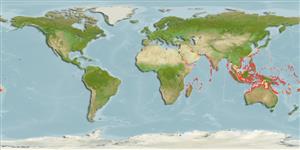Common names from other countries
>
Gobiiformes (Gobies) >
Gobiidae (Gobies) > Gobiinae
Etymology: Amblyeleotris: Greek, amblys = darkness + The name of a Nile fish, eleotris (Ref. 45335).
More on author: Bleeker.
Environment: milieu / climate zone / depth range / distribution range
Ecologia
marinhas associadas(os) a recifes; intervalo de profundidade 5 - 35 m (Ref. 48637), usually 10 - 20 m (Ref. 27115). Tropical; 22°C - 28°C (Ref. 27115); 35°N - 23°S, 32°E - 174°W
Indo-West Pacific: Persian Gulf (Ref.80050) and Red Sea to Tonga, north to Japan and south to Australia.
Tamanho / Peso / Idade
Maturity: Lm ? range ? - ? cm
Max length : 11.0 cm SL macho/indeterminado; (Ref. 48637)
Descrição breve
Chaves de identificação | Morfologia | Morfometria
Espinhos dorsais (total) : 7; Raios dorsais moles (total) : 12; Espinhos anais: 1; Raios anais moles: 12. Characterized by whitish body color; head and side with six brown to reddish bars and irregular brown blotches in pale spaces in between; four branched main body bars on lower side; red blotch on lower cheek just behind mouth; red or orange spots on head, dark-edged; separate pelvic fins, joined by low membrane at base of fins; without median predorsal scales or only few embedded scales just in front of first dorsal fin; longitudinal scale series 80-85; greatest depth of body 4.6-6.4 in SL; caudal fin longer than head, 2.8-3.4 in SL (Ref. 90102).
Inhabits coastal to outer reef sand slopes to 35 meters depth (Ref. 48637); on sandy areas of lagoon and seaward reefs (Ref. 9710). Inhabits burrows with alpheid shrimps (Ref. 11441).
Life cycle and mating behavior
Maturities | Reprodução | Spawnings | Egg(s) | Fecundities | Larvas
Myers, R.F., 1991. Micronesian reef fishes. Second Ed. Coral Graphics, Barrigada, Guam. 298 p. (Ref. 1602)
Categoria na Lista Vermelha da IUCN (Ref. 130435)
CITES (Ref. 128078)
Not Evaluated
Ameaça para o homem
Harmless
Utilização humana
Pescarias: espécies comerciais; Aquário: Espécies comerciais
Ferramentas
Relatórios especiais
Descarregue XML
Fontes da internet
Estimates based on models
Preferred temperature (Ref.
115969): 25.2 - 29.1, mean 28 (based on 484 cells).
Phylogenetic diversity index (Ref.
82804): PD
50 = 0.5000 [Uniqueness, from 0.5 = low to 2.0 = high].
Bayesian length-weight: a=0.00708 (0.00333 - 0.01504), b=3.09 (2.92 - 3.26), in cm Total Length, based on LWR estimates for this (Sub)family-body shape (Ref.
93245).
Nível Trófico (Ref.
69278): 3.4 ±0.4 se; based on size and trophs of closest relatives
Resiliência (Ref.
120179): Elevada, tempo mínimo de duplicação da população menor que 15 meses (Preliminary K or Fecundity.).
Fishing Vulnerability (Ref.
59153): Low vulnerability (10 of 100).
